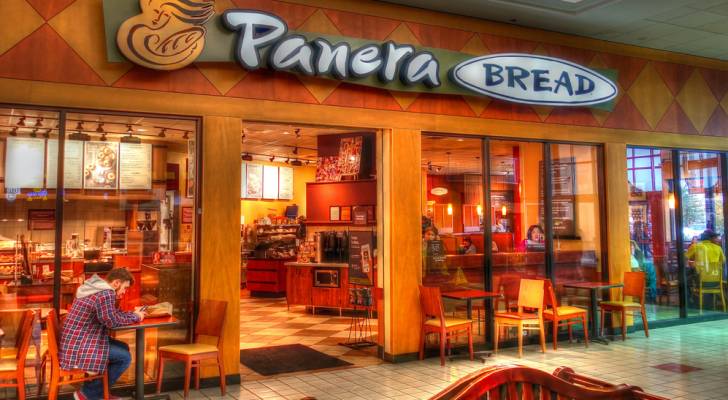
For the past few years, the only thing rising at Panera Bread has been the prices. Everything else has been shrinking.
That includes the staffing, sandwiches and — not surprisingly — the customer base and revenue, which fell 5% to $6.1 billion last year, as CNBC reports.
Panera CEO Paul Carbone is brutally honest about the situation, describing it as “death by 1,000 paper cuts.”
Must Read
- Real Estate: Thanks to Jeff Bezos, you can now become a landlord for as little as $100 — and no, you don’t have to deal with tenants or fix freezers. Here’s how
- Retirement: Dave Ramsey warns nearly 50% of Americans are making 1 big Social Security mistake — here’s what it is and 3 simple steps to fix it ASAP
- Investing: Warren Buffett used 8 solid, repeatable money rules to turn $9,800 into a $150B fortune. Start using them today to get rich (and stay rich)
“When the guest comes into the cafe to buy an expensive sandwich of lower quality and a smaller size, they’re met with a cafe that we stripped a lot of labor on so there is no one to talk to,” Carbone told the publication QSR Magazine (1).
So he’s hoping a new strategy, ‘Panera RISE’ will see more expansion than shrinkage, as the chain moves away from cost-cutting toward an enhanced customer experience, with more attractive meals and lower prices on several items (2).
Carbone, who became CEO in March, has ambitious goals for the restaurant chain, aiming to achieve $7 billion in revenue by 2028. [3]
Will Panera rise to the challenge? Here’s a look at the broader economic environment affecting the restaurant industry and how to get the most bang for your buck when you eat out.
American diners’ backlash against shrinkflation
As the cost of living puts a squeeze on households across the U.S., consumers are looking for value when they eat out.
Unfortunately, a lot of diners have noticed shrinking portions and rising prices not only at Panera, but across the board.
Read more: Robert Kiyosaki says this 1 asset will surge 400% in a year — and he begs investors not to miss its ‘explosion’
The data backs up the observation. The cost of eating out rose 3.7% between September 2024 and September 2025, according to the Bureau of Labor Statistics.
That’s driving a backlash. People are voting with their feet, which are more frequently planted at home these days..
YouGov, an international market research and data analytics firm, reports that more than a third of Americans (37%) are dining out less frequently in 2025, citing a rise in cost as the primary reason for skipping a meal out (4).
With most Americans agreeing that discounts and value options may encourage them to eat out more, a ‘value war’ has broken out across food joints like Panera that are seeking to appeal to cost-conscious consumers.
When compared to other fast-casual options, like Chipotle, Panera offers a wider range of price points.
It’s more expensive than McDonald’s, but with most Americans spending between $11 and $20 per meal out of the house, Panera’s updated menu is in line with what people seem willing to spend (5).
How to get the most bang for your buck when eating out
While people across the U.S. are cutting back on dining out, they’re not cutting it out altogether.
According to CNET, the average American spends $236.76 a month on restaurants and takeout, reportedly due to a lack of time for meal prep and grocery shopping (6).
If you want to get the most out of your dollars when dining out, seek out restaurants that are advertising value options like Panera and McDonald’s ‘Extra Value Meals’.
You might be pleasantly surprised. As Fortune reports, many households are opting to eat at sit-down chains like Chili’s and Cheesecake Factory because the costs are similar to fast-food options, but the experience is more elevated (7).
While food costs might start to feel more palatable at certain chains, it seems unlikely that full-service restaurants can afford to dive into lower costs due to sustained higher labor costs.
The most effective way to save money on food costs is to stick to eating more meals at home.
Between smart grocery shopping and price matching, opting to cook more meals in your own kitchen could be easier on your budget.
What to read next
- ‘Hold onto your money’: Jeff Bezos issued a warning to rethink buying a ‘new automobile, refrigerator, or whatever’ — does it hold true today?
- Dave Ramsey says this 7-step plan ‘works every single time’ to kill debt, get rich — and ‘anyone’ can do it
- I’m almost 50 years old and have nothing saved for retirement. What do I do? Don’t panic. Here are 6 easy ways to catch up (and fast)
- 22 US states are already in a recession — protect your savings with these 10 essential money moves ASAP
Join 200,000+ readers and get Moneywise’s best stories and exclusive interviews first — clear insights curated and delivered weekly. Subscribe now.
Article sources
We rely only on vetted sources and credible third-party reporting. For details, see our editorial ethics and guidelines.
QSR (1); Panera Bread (2); CNBC (3); YouGov (4); Escoffier School of Culinary Arts (5); CNET (6); Fortune (7)
This article provides information only and should not be construed as advice. It is provided without warranty of any kind.